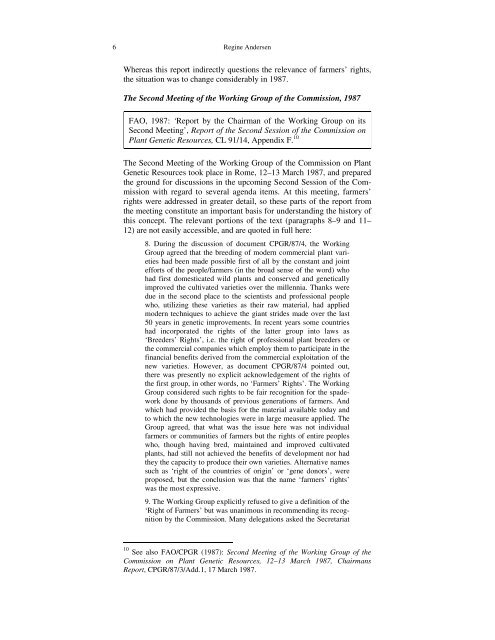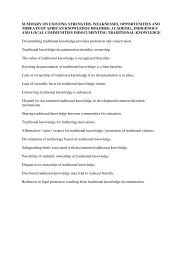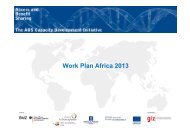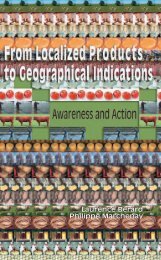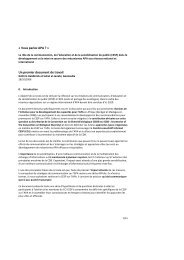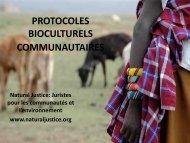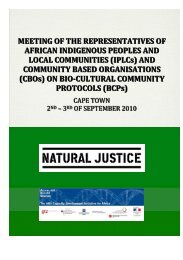The History of Farmers' Rights - Fridtjof Nansens Institutt
The History of Farmers' Rights - Fridtjof Nansens Institutt
The History of Farmers' Rights - Fridtjof Nansens Institutt
You also want an ePaper? Increase the reach of your titles
YUMPU automatically turns print PDFs into web optimized ePapers that Google loves.
6 Regine Andersen<br />
Whereas this report indirectly questions the relevance <strong>of</strong> farmers’ rights,<br />
the situation was to change considerably in 1987.<br />
<strong>The</strong> Second Meeting <strong>of</strong> the Working Group <strong>of</strong> the Commission, 1987<br />
FAO, 1987: ‘Report by the Chairman <strong>of</strong> the Working Group on its<br />
Second Meeting’, Report <strong>of</strong> the Second Session <strong>of</strong> the Commission on<br />
Plant Genetic Resources, CL 91/14, Appendix F. 10<br />
<strong>The</strong> Second Meeting <strong>of</strong> the Working Group <strong>of</strong> the Commission on Plant<br />
Genetic Resources took place in Rome, 12–13 March 1987, and prepared<br />
the ground for discussions in the upcoming Second Session <strong>of</strong> the Commission<br />
with regard to several agenda items. At this meeting, farmers’<br />
rights were addressed in greater detail, so these parts <strong>of</strong> the report from<br />
the meeting constitute an important basis for understanding the history <strong>of</strong><br />
this concept. <strong>The</strong> relevant portions <strong>of</strong> the text (paragraphs 8–9 and 11–<br />
12) are not easily accessible, and are quoted in full here:<br />
8. During the discussion <strong>of</strong> document CPGR/87/4, the Working<br />
Group agreed that the breeding <strong>of</strong> modern commercial plant varieties<br />
had been made possible first <strong>of</strong> all by the constant and joint<br />
efforts <strong>of</strong> the people/farmers (in the broad sense <strong>of</strong> the word) who<br />
had first domesticated wild plants and conserved and genetically<br />
improved the cultivated varieties over the millennia. Thanks were<br />
due in the second place to the scientists and pr<strong>of</strong>essional people<br />
who, utilizing these varieties as their raw material, had applied<br />
modern techniques to achieve the giant strides made over the last<br />
50 years in genetic improvements. In recent years some countries<br />
had incorporated the rights <strong>of</strong> the latter group into laws as<br />
‘Breeders’ <strong>Rights</strong>’, i.e. the right <strong>of</strong> pr<strong>of</strong>essional plant breeders or<br />
the commercial companies which employ them to participate in the<br />
financial benefits derived from the commercial exploitation <strong>of</strong> the<br />
new varieties. However, as document CPGR/87/4 pointed out,<br />
there was presently no explicit acknowledgement <strong>of</strong> the rights <strong>of</strong><br />
the first group, in other words, no ‘Farmers’ <strong>Rights</strong>’. <strong>The</strong> Working<br />
Group considered such rights to be fair recognition for the spadework<br />
done by thousands <strong>of</strong> previous generations <strong>of</strong> farmers. And<br />
which had provided the basis for the material available today and<br />
to which the new technologies were in large measure applied. <strong>The</strong><br />
Group agreed, that what was the issue here was not individual<br />
farmers or communities <strong>of</strong> farmers but the rights <strong>of</strong> entire peoples<br />
who, though having bred, maintained and improved cultivated<br />
plants, had still not achieved the benefits <strong>of</strong> development nor had<br />
they the capacity to produce their own varieties. Alternative names<br />
such as ‘right <strong>of</strong> the countries <strong>of</strong> origin’ or ‘gene donors’, were<br />
proposed, but the conclusion was that the name ‘farmers’ rights’<br />
was the most expressive.<br />
9. <strong>The</strong> Working Group explicitly refused to give a definition <strong>of</strong> the<br />
‘Right <strong>of</strong> Farmers’ but was unanimous in recommending its recognition<br />
by the Commission. Many delegations asked the Secretariat<br />
10 See also FAO/CPGR (1987): Second Meeting <strong>of</strong> the Working Group <strong>of</strong> the<br />
Commission on Plant Genetic Resources, 12–13 March 1987, Chairmans<br />
Report, CPGR/87/3/Add.1, 17 March 1987.


